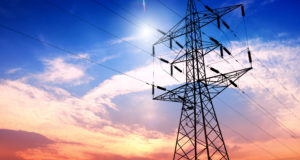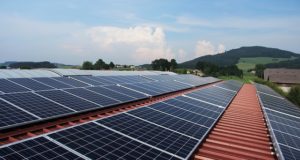The sun is truly an eternal presence in our sky, its tides of life-giving heat and light washing across the surface of our small blue planet each and every day. Starlight literally permeates every fiber of our beings, and without the sun’s energy to provide the earth’s surface with sustenance this would be a cold, dead world indeed.
In an age where technological know-how is respected above all else, harnessing and manipulating the powers of nature for man’s benefit has become the organizing principle of our entire society. Given this orientation, it is hardly surprising that modern inventors and entrepreneurs have focused on the sun as a potential source of limitless energy. If only we could find more efficient and cost-effective ways to capture and store the sun’s heat and light, it is said, that energy could finally provide us with a cheap and reliable source of electricity. It could revolutionize our society and economy, while changing our relationship to nature completely and irrevocably.
 Whether or not the promise of solar energy turns out to be more hype than reality has yet to be determined. Solar has come a long way in the past few decades, but it still has a long way to go before it will be ready to replace the burning of fossil fuels as our primary method for generating electrical power. But in our rush to “conquer” the sun, it seems as if we have overlooked something very important and very significant. While other sources of energy must be harvested and processed in order to be converted into a useful form, this is really not necessary at all in the case of the sun. There is no disputing that solar photovoltaics are already producing energy and hold at least some promise for expanded use in the future, but that doesn’t change the fact that the sun is already supplying us with plentiful amounts of energy, entirely for free, and we would be foolish not to take full advantage of this wonderful gift from God in its raw, natural, unmediated form.
Whether or not the promise of solar energy turns out to be more hype than reality has yet to be determined. Solar has come a long way in the past few decades, but it still has a long way to go before it will be ready to replace the burning of fossil fuels as our primary method for generating electrical power. But in our rush to “conquer” the sun, it seems as if we have overlooked something very important and very significant. While other sources of energy must be harvested and processed in order to be converted into a useful form, this is really not necessary at all in the case of the sun. There is no disputing that solar photovoltaics are already producing energy and hold at least some promise for expanded use in the future, but that doesn’t change the fact that the sun is already supplying us with plentiful amounts of energy, entirely for free, and we would be foolish not to take full advantage of this wonderful gift from God in its raw, natural, unmediated form.
“Passive solar” is the label that is most frequently used to describe natural sunlight as a form of energy, and it is in the area of building construction – particularly home construction – that passive solar has really taken wing. As its principles have developed, passive solar design for heating and cooling (passive solar for lighting is a separate topic) has come to be associated with four different aspects: glazing, shading, thermal mass, and insulation. Home construction and renovation projects are incorporating passive solar design features related to one or more of these factors left and right these days, and if you are planning on building a new home or refurbishing your old one anytime soon, you really owe it to yourself to take a good hard look at what passive solar might be able to do for you.
Glazing
Before the sun can begin performing its energy-saving magic, first you must give it access to your humble abode by installing windows on the sides of your home that face the sun during the daytime. If you live in North America, the southern side of your house should have the most windows because it will be bathed in sunlight most frequently, but a good glazing scheme should also include windows on the eastern and western sides so that the heat and light provided by the rising and setting sun respectively can also gain access to your home’s interior.
In the past, builders and designers thinking about the sun always went on the assumption that when it came to glass more was better, so when constructing homes in areas with low wintertime temperature patterns the general practice was to try and install as much glazing as possible on the southern facade. But there are two problems with this approach. First, even though the heat and light of the sun are most welcome during the winter months, when glass windows are too large daytime temperatures can become unbearably hot on even the coldest days. Second, while sunlight can enter easily through windows during the day, the heat it generates can just as easily leak out through them during the night, since glass lacks good insulating properties. The effectiveness of glazing as a method for harvesting passive solar energy is maximized when windows in the home cover an area equivalent to 7-12% of the floor area of the space being heated, and if you use more glazing than this, you will actually lose more than you gain in the end.
One method for improving the performance of glazing is to cover either the inside or outside of your windows with clear plastic during the wintertime months. This can improve the insulating qualities of glass without decreasing their ability to absorb sunlight during the day.
Shading
As wonderful as southern glazing can be during the winter months in northern climes, windows unquestionably cause interior heat levels to rise during the summer, which is why homes designed to absorb passive solar energy for the purposes of heating also need to be cleverly designed and landscaped to keep the sun out when the heat of the day is at its most intense. This is where shading comes in, and while the term “solar cooling” may not be technically correct here (how could you use sunlight to make something cooler?) it does capture the essence of the idea.
The trick of course is to come up with methods of shading your home that will protect it from sunlight in the summer but allow the sun’s rays to penetrate the home’s windows again during the winter. Planting deciduous shade trees that lose their leaves over the winter is of course one of the best ways to provide variable shade for the southern facade of a home, and this method will work quite well for windows placed on the lower floor of a home in particular.
One potential problem is that if trees are planted too close to the home, just their bulk alone may be enough to block out the sun in the wintertime, even if they have lost all of their leaves. As a general rule, to avoid this problem you should plant your deciduous trees no closer to your home than two-and-a-half times their mature height on the south side, and no closer than four times that height if your trees are going to be planted on the southeast or southwest corners. If possible, you will also want the trees you select to grow tall enough to shade upper floor windows from the high summertime sun, and if this is not possible you might want to consider restricting your southern glazing to the lower floor of your house.
The other way to effectively shade a home is to put in roof overhangs or extensions. The reason these work so well is because the sun changes its angle or declination in the sky as the months pass by, so overhangs will block the sun during the summer when it is at its zenith but permit its light to penetrate the house’s glazing in winter when the sun is at its nadir.
Thermal Mass
Building materials such as stone, concrete, and brick are said to have high thermal mass because of their ability to absorb significant amounts of heat from the surrounding atmosphere. While materials with low thermal mass such as timber tend to quickly lose any heat they take in, heavier building elements act as heat sinks that will soak up and store heat from a warm environment during the day and then slowly re-emit it at night when interior temperatures go down. Materials with high thermal mass, when used to make the floors, walls, and other fixed furnishings on the interior of homes, have a tendency to promote twenty-four-hour thermal equilibrium by regulating temperature extremes naturally. This makes them ideal for use inside of homes constructed in climates that experience large variations in daily high and low temperatures, such as you might find in a desert or mountain area for example.
In the past, the concept of thermal mass was not well understood, and while glazing was overdone, the heat-preserving and regulating abilities of concrete, stone, and brick were overlooked and seldom exploited. Things have changed dramatically, however, and those building new homes based on passive solar principles are now using hard and heavy materials on the interiors much more frequently. One new idea that is starting to catch on (they are crazy about it in Australia) is reverse brick veneering, which flips the older style of wall construction on its head by putting the brick on the inside and the timber on the outside, creating walls that combine a good aesthetic impression with excellent thermal mass qualities.
Amazing “Solar Generator” Is Like Having A Secret Power Plant Hidden In Your Home!
Insulation
You can capture and store all of the sun’s energy you want, but if you are trying to use it to keep a home warm on winter nights, all the thermal mass in the world won’t help you if your house is not well insulated. There is really nothing very tricky here – basically, anything with good thermal mass should be protected on the outside by insulation, otherwise any heat it emits at night will simply disappear through the exterior walls. And of course, any building material used that has poor thermal mass also must be insulated to keep the heat loss problem from becoming even worse. In the well-designed passive solar home, insulation essentially fills the role of the outer shell or skin, keeping all of that wonderful heat and energy that has been captured from the sun trapped on the inside where it can be put to good use.
The Sun’s Eternal Grid
More energy hits the earth’s surface in the form of sunlight each second than is consumed by the entire human population of the planet over the course of a whole year. This never-ending cascade of light and warmth is a sign of the unlimited greatness that defines our Creator, but astonishingly, up until now we have only making good use of a small portion of this amazing natural bounty.
Passive solar design and building practices are helping us change this habit of neglect. This field is growing fast because passive solar principles can save us a lot of money while decreasing our dependence on the man-made grid, which on its best day will never be able to match the unbounded perpetual output of the nearby star that continues to bathe us in its warm breath of life each and every second of every single day.
©2012 Off the Grid News
 Off The Grid News Better Ideas For Off The Grid Living
Off The Grid News Better Ideas For Off The Grid Living




